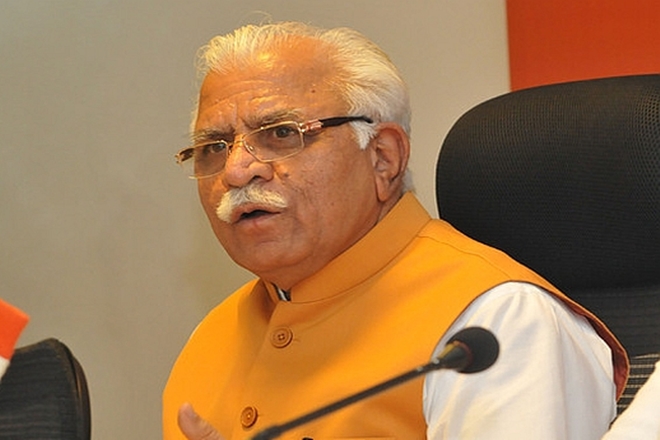Chandigarh: When Prime Minister Narendra Modi handpicked Manohar Lal Khattar as Haryana’s chief minister in 2014, the decision took many by surprise.
He did not come from the dominant Jat community, spoke Punjabi and had no administrative experience. But even as a first-time MLA, he was asked to head the first Bharatiya Janata Party (BJP) government ever in the state.
“There were people who used to say I am new and lack experience. Some even branded me an ‘anadi’ (novice). But now the very same people say I am not an ‘anadi’ but a ‘khiladi’ (player) of politics,” Khattar, 65, had said at several election meetings before the October 21 Assembly polls.
Though the BJP in Haryana benefitted from the party’s continuing dominance at the national level, Thursday’s assembly election results have put Khattar’s leadership under test.
The BJP, which had formed government for the first time on its own in Haryana by winning 47 of the 90 seats, and had set a target to win more than 75 seats this time, could manage only 40, falling short of a simple majority by six.
Notwithstanding the ruling outfit’s claims of providing a clean, transparent, corruption-free government, political observers say what worked to the BJP’s disadvantage was the strategy to consolidate the non-Jat vote in an apparent bid to counter Jat dominance in the state’s politics.
Eight of Khattar’s ministers also lost the polls that included some prominent faces from the Jat community, including Abhimanyu and Om Prakash Dhankar.
Now, with his party taking support of seven Independents and the 10-month old Jannayak Janta Party (JJP), and making its leader Dushyant Chautala his deputy, Khattar faces the challenge of running a coalition government.
The JJP is likely to keep its senior partner on toes, asking it to implement the poll promises the fledgling outfit made to the people before the polls.
Khattar joined the Rashtriya Swayamsevak Sangh (RSS) when he was 24 in 1977 and moved to the BJP in 1994. He first began working with Modi, who himself is an RSS paracharak, in 1996, when the senior leader was in charge of the state for the BJP.
In 2002, Khattar was made the election in-charge of Jammu and Kashmir.
Khattar, a bachelor known for his simple lifestyle, earned himself a reputation as a tough taskmaster while working behind the scenes in key positions in the BJP, and was admired for organisational skills.
He played a key role in many electoral campaigns and was the chairman of the party’s election campaign committee in Haryana in the 2014 Lok Sabha polls.
Khattar also headed ‘Antyodaya Yojana’ for the BJP at the national level, which symbolised the the party’s ideology to elevate those in the lowest rung of the society.
However, it was his proximity to Modi that seemed to have catapulted him to the chief minister’s post when he edged out veterans like Ram Bilas Sharma, Anil Vij and OP Dhankar in October 2014.
Destiny clearly had something else in store for the man whose childhood ambition was to become a doctor. Instead, he became the state’s first Punjabi speaking chief minister, and the first non-Jat leader to occupy the post after 18 years.
Khattar, born in Nindana, a village in Haryana’s Rohtak district, hails from a humble agricultural background. His family arrived in Haryana from Pakistan after the Partition.
They settled at Nindana. His father and grandfather took to farming, finally saving enough to start a small shop.
He became the first member of his family to study beyond class 10, when he enrolled himself in Neki Ram Sharma Government College in Rohtak.
He travelled to Delhi to prepare for a medical entrance test, initiating a chain of events that transformed his life.
Despite facing pressure from his family to stick to farming, he took to business and simultaneously graduated from the Delhi University. In 1977, he joined the RSS.
As chief minister, he consolidated his position when the BJP won all the five mayoral seats last year followed by victory in the Jind bypolls this year. What added to his stature later was the party’s clean sweep in the general elections where it won all the 10 seats from the state.
Khattar’s government claims to have brought in transparency in all the spheres, providing a “corruption-free” government, giving jobs on merit, initiating several welfare schemes, upgrading infrastructure and bringing a law on minimum educational qualification criteria to fight the panchayat polls.
His government survived a string of challenges, including violence triggered by action against self-styled godman Rampal in November 2014, Jat quota stir in 2016, and violence after the conviction of Dera Sacha Sauda chief Gurmeet Ram Rahim Singh in 2017. About 80 lives were lost in these incidents.
In his first term what worked to his and the BJP’s advantage was the absence of a strong opposition in the state. There has been infighting in the state unit of the Congress and a feud in the Chautala clan led to a split in the once-powerful Indian National Lok Dal (INLD).
Over decades, Haryana’s politics revolved around three Lals — former chief ministers Devi Lal, Bansi Lal and Bhajan Lal, and sometimes Khattar’s supporters like to call him Haryana’s “fourth Lal”.
